.
...and in as much as at the first on the hazy sea
I sprang upon the swift ship in the form of a dolphin,
pray to me as Apollo Delphinius; also the altar itself
shall be called Delphinius and overlooking for ever.
Homer, To Apollo (probably a work of some other poet )
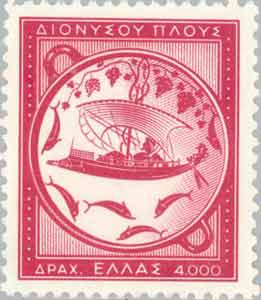
Dionysus and pirates (Attic BF kylix) 530 BC by Exekias (Munich: Antikensamml. Inv. 8729) As an exercise find where the pirates are! As a young man, Dionysus was exceptionally attractive. Once, while disguised as a mortal on a ship, the sailors attempted to kidnap him for their sexual pleasures. Dionysus mercifully turned them into dolphins but saved the captain, Acoetes, who recognized the god and tried to stop his sailors.
Dolphins are certain aquatic mammals related to whales and porpoises. The name is from Ancient Greek δελφίς delphis meaning "with a womb", viz. "a 'fish' with a womb".
Dolphins appear in a number of Greek myths, invariably as helpers of humankind. Dolphins also seem to have been important to the Minoans, judging by artistic evidence from the ruined palace at Knossos.
A dolphin rescued the poet Arion from drowning and carried him safe to land, at Cape Taenarum, now Cape Matapan, a promontory forming the southernmost point of the Peloponnesus. There was a temple to Poseidon and a statue of Arion riding the dolphin. (Herodotus I.23; Thucydides I.128, 133; Pausanias iii.25, 4)
Among other offerings on Taenarum is a bronze statue of Arion the harper on a dolphin. Herodotus has told the story of Arion and the dolphin, as he heard it, in his history of Lydia. I have seen the dolphin at Poroselene that rewards the boy for saving his life. It had been damaged by fishermen and he cured it. I saw this dolphin obeying his call and carrying him whenever he wanted to ride on it. Pausanias
Apollo's first achievement was to kill the dragon (or giant serpent) Pytho protecting the sanctuary of Pytho from its lair beside the Castalian Spring. There it stood guard while the Sibyl gave out her prophecies as she inhaled the trance inducing vapors from an open chasm. However, to make amends for killing Pytho, as the fearsome beast was the son of Gaia, Apollo had to serve king Admetus for nine years as a cowherd. This he did, and when he returned to Pytho he came in the guise of a dolphin bringing with him priests from Crete. Apollo's cult title "Delphinios" meaning dolphin or porpoise, is probably how Delphi was so named.
In the seas between Cyrene and Egypt there is a fish that attends on the dolphin, which is called the ‘dolphin’s louse’. This fish gets exceedingly fat from enjoying an abundance of food while the dolphin is out in pursuit of its prey. Aristotle, History of Animals
The Greeks reimagined the Phoenician god Melqart as Melikertês (Melicertes) and made him the son of Athamas and Ino. He drowned but was transfigured as the marine deity Palaemon, while his mother became Leucothea. (cf Ino.) At Corinth, he was so closely connected with the cult of Poseidon that the Isthmian Games, originally instituted in Poseidon's honor, came to be looked upon as the funeral games of Melikertes.
Phalanthus was another legendary character brought safely to shore (in Italy) on the back of a dolphin, according to Pausanias.

Delos Mosaic
Many seals and coins show a man or boy riding a dolphin.
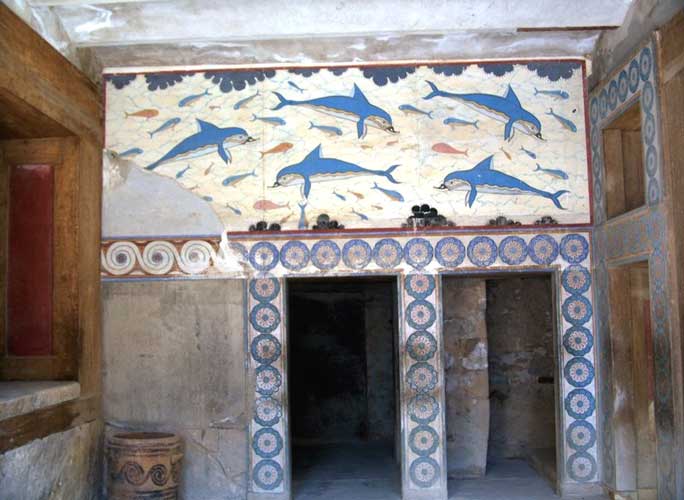
Knossos, Minoan fresco with Dolphins
Three poets, Anyte, Archias and Antipater, lament the fate of a dolphin which was cast on land during a tempest and then (says one of them) reverently buried by the country-folk. Another such creature is praised for having conveyed a weary, storm-tossed nightingale, friend of man, from the ocean to the beach; a third for performing the same humanitarian office to a dripping corpse and thereby losing its life, since it was left stranded high and dry on the shore. The most famous of corpse-transporting dolphins was probably that which brought to land the body of Hesiod, thrown into the sea by the sons of Phegeus, who suspected him of seducing their sister (Contest of Homer and Hesiod). According to a — non-Anthology — Greek legend, a certain of these officious sea-beasts on one occasion made a lamentable gaffe. It picked up, in mistake for a man, a living monkey which had been washed overboard near the Attic coast, and only discovered its error at the last moment, when, disgusted with the blunder, it left the poor monkey to drown within a few yards of the shore. The souls of the human dead, in the form of butterflies, were borne to the Elysian Fields on the back of a dolphin.
Norman Douglas, Birds and Beasts of the Greek Anthology
The dolphin is in fact an animal which is very fond of men, and very intelligent, and one very susceptible of gratitude. Accordingly, Phylarchus, in his twelfth book, says:--
"Coiranus the Milesian, when he saw some fishermen who had caught a dolphin in a net, and who were about to cut it up, gave them some money and bought the fish, and took it down and put it back in the sea again. And after this it happened to him to be shipwrecked near Myconos, and while every one else perished, Coiranus alone was saved by a dolphin. And when at last he died of old age in his native country, as it so happened that his funeral procession passed along the seashore close to Miletus, a great shoal of dolphins appeared on that day in the harbor, keeping only a very little distance from those who were attending the funeral of Coiranus, as if they also were joining in the procession and sharing in their grief." Athenaeus
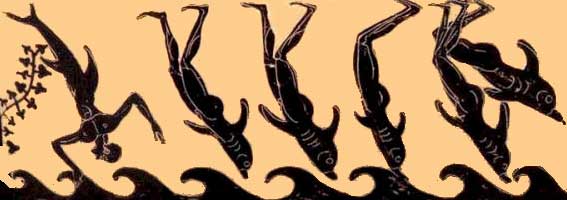
Pirates transforming into dolphins. Drawing from an Etruscan Black Figure Hydria, Micali Painter, 510-500 BC
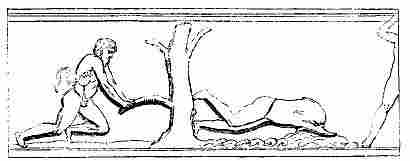
Relief, Transformation of a pirate into a dolphin
-----------------------
The word Dolphin is used in a few different ways. It can mean:
any member of the family Delphinidae (oceanic dolphins),
any member of the families Delphinidae and Platanistoidae (oceanic and river dolphins),
any member of the suborder Odontoceti (toothed whales; these include the above families and some others),
laypeople often use the term synonymously with Bottlenose Dolphin, the most common and familiar species of dolphin.
Porpoises (suborder Odontoceti, family Phocoenidae) are thus not dolphins in our sense. Orcas and some related species belong to the Delphinidae family and therefore qualify as dolphins, even though they are called whales in common language.
There are almost 40 species of dolphin in 17 genera. They vary in size from 1.2 metres and 40 kg (Heaviside's Dolphin), up to 9.5 metres and 10 tonnes (the Orca). Most species weigh between about 50 and about 200 kg. They are found worldwide, mostly in the shallower seas of the continental shelves, and all are carnivores, mostly taking fish and squid.
The family Delphinidae is the largest in the Cetacea, and relatively recent: dolphins evolved about 10 million years ago, during the Miocene.
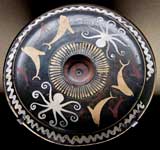
Venus with dolphin. "Mazarin Venus" 2nd cent. AD copy of Hellenistic original , Santa Monica, Getty Museum. Credits: Barbara McManus, 1991
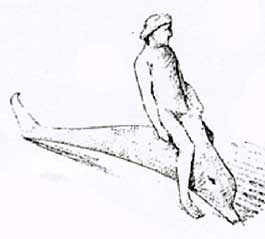
Sculpture from the Acropolis, Asty Newspaper
See also Enalus
Psykter (Ψυκτήρ), Hoplites Riding Dolphins
Bulfinch's Mythology, The Age of Fable: Arion
| Ancient Greece
Science, Technology , Medicine , Warfare, , Biographies , Life , Cities/Places/Maps , Arts , Literature , Philosophy ,Olympics, Mythology , History , Images Medieval Greece / Byzantine Empire Science, Technology, Arts, , Warfare , Literature, Biographies, Icons, History Modern Greece Cities, Islands, Regions, Fauna/Flora ,Biographies , History , Warfare, Science/Technology, Literature, Music , Arts , Film/Actors , Sport , Fashion --- |
Retrieved from "http://en.wikipedia.org/"
All text is available under the terms of the GNU Free Documentation License
